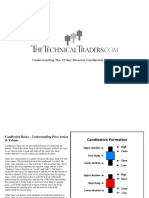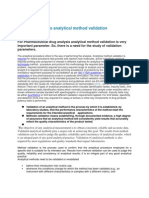Technical Analysis
Technical Analysis
Uploaded by
Ken EncisoCopyright:
Available Formats
Technical Analysis
Technical Analysis
Uploaded by
Ken EncisoOriginal Title
Copyright
Available Formats
Share this document
Did you find this document useful?
Is this content inappropriate?
Copyright:
Available Formats
Technical Analysis
Technical Analysis
Uploaded by
Ken EncisoCopyright:
Available Formats
Technical Analysis: Getting Started
Basic Introduction and Beginner’s Guide
Created by: Aditya Agarwal ‘22
Introduction
In this tutorial, we will be exploring what technical analysis is, how to read candlestick charts, and common
patterns that traders look for.
What is Technical Analysis?
Technical analysis is the practice of using historical data and current price action to predict future price
movements. Technical analysis uses price charts to identify signals and patterns that provide a lens into
market psychology. Technical traders aim to benefit from this analysis by catching trend reversals and riding
price momentum.
This analysis is significantly different from fundamental analysis, which is a longer-term analysis evaluating
the financial strength and growth prospects of a company. While fundamental analysis can be more
beneficial for long-term investing, technical analysis is helpful for timing entries, exits, and shorter-term
trades. Together, technical and fundamental analysis can be coupled to create a trading strategy geared
towards providing alpha.
How to Read a Candlestick Chart
One of the fundamental understandings necessary to learning
technical analysis is reading candlestick charts. If you have
never studied technical analysis, chances are you have only
used a line chart. Line charts only provide one data point, the
closing price of a stock, but candlestick charts provide five:
open, close, low of day (LOD), high of day (HOD), and direction
of movement. A visualization of how a candlestick chart
provides this information is illustrated on the left.
Each candle can represent anywhere from 1 minute to 1 year
depending on the settings. Longer time frame charts are more
likely to provide reliable long-term trends.
I highly recommend using tradingview.com to view candlestick charts. They are one of the best online
platforms to view candlestick charts and conduct technical analysis for free.
Support and Resistance
One of the most basic technical indicators consist of support
and resistance. As the words indicate, support is typically a
price level at which there have historically been buyers.
Resistance consists of price level where there have historically
been sellers. As a result, price tends to bounce at support and
pullback at resistance. However, these price levels change
based off of catalysts. When resistance is broken, it acts as
support in the future, and when support breaks, it acts as
resistance in the future. An example of this can be seen on the
left.
2|Introduction to Technical Analysis
Common Candlestick Signals
Assume each candle represents one day for each of the following examples.
1. Hammer Candle
Pictured to the left is a hammer candle. This type of candle typically
consists of a green body with little to no upper wick, and a long lower
wick. This signifies that price action during the day was down trending,
but buyers came in to retrace the price all the way back to opening
price, and then some more.
This candle is usually a sign of a reversal, or at least a dead cat
bounce in a downtrend. An example of this signal being used can be
observed on ticker CRL on March 5th, 2021.
2. Shooting Star
This candle structure is opposite to the hammer candle, and is a
bearish signal. It typically consists of a red body with little to no lower
wick, and a long upper wick. Logically speaking, this shows price
action increasing after open, followed by sellers pushing the price
back down all the way to the opening price, and then some more.
This candle is usually a sign of a reversal, or at least a pullback in an uptrend. An example of this signal
being used can be observed on ticker SPOT on November 2nd, 2021.
3. Bullish Engulfing
This is a bullish signal that occurs when one day’s range completely
covers the previous day’s range. Typically, the first day is a bearish
red candle, covered by the following day’s bullish green candle that
opens lower than the previous day and closes above the previous
day’s range. The buyers regain control and push the price up,
indicating a bullish signal.
An example of this signal being used can be observed on ticker SPY on June 21 st, 2021.
4. Bearish Engulfing
This candle structure is the opposite of the bullish engulfing, and is a
bearish signal. It typically consists of one day’s bearish range
completely engulfing the previous day’s range. The sellers take control
and push the price down, indicating a bearish signal.
An example of this signal being used can be observed on ticker NCLH
on June 9th, 2021.
There are many more signals that you can learn about here: https://www.ig.com/us/trading-strategies/16-
candlestick-patterns-every-trader-should-know-180615
3|Introduction to Technical Analysis
Common Chart Patterns
Assume each candle represents one day for each of the following examples.
1. Head and Shoulders
The head and shoulders pattern is one of the strongest
indicators of an uptrend reversing to a downtrend. In this
pattern, there is one large peak, or high, with two slightly
lower highs on each side. The peak is referred to as the
head, and the two lower highs are considered the
shoulders. Once the third peak falls below the neckline, or
the support level from the previous two lows, it is likely
that the stock will enter a downtrend. This is because the
stock was previously creating higher highs and higher lows in an uptrend, but a break of the neckline after a
lower high signifies that the stock is now creating lower highs and lower lows. An example of this pattern can
be observed on ticker TSLA from Jan 7th to Jan 22nd, 2021. After breaking the neckline, TSLA continued on
its downtrend until March 8th, 2021, resulting in almost a 25% depreciation in price from Jan 22 nd.
The opposite of this pattern is known as the Inverse Head and Shoulders. This pattern has one low bottom
with two slightly lower lows on each side. If the neckline breaks, it is likely that the stock will reverse from an
uptrend to a downtrend. An example of this pattern can be observed on ticker ADSK from September 8 th to
October 9th, 2021. After breaking the neckline, ADSK continued its uptrend until Jan 8th, 2021, resulting in an
approximately 40% appreciation in stock price.
2. Double Top
The double top pattern is another pattern that signifies a
trend reversal from an uptrend to a downtrend. In this
pattern, a stock’s price will peak and retrace to a support
level before pushing back up to retest the peak. Once
rejected, the stock will push back down and break its
known support level. This confirms similar highs and
lower lows, indicating the start of a downtrend.
An example of this pattern can be observed on ticker
NKE from November 5th to December 13th, 2021. Prices
hit resistance around $177.5 on November 5th and
November 22nd before breaking the support level of $167
on December 14th. As of today, December 20th, 2021, NKE has continued falling.
The opposite of this pattern is known as the Double Bottom. This pattern has two bottoms that act as
support near a similar price level. The stock then breaks through resistance to begin a new uptrend. An
example of this pattern can be observed on ticker MSFT from May 12 th to June 4th, 2021. MSFT had a
double bottom around $$239, and entered an uptrend until September 24 th since it broke the resistance level
of $247.
There are many more chart patterns that you can learn about here: https://www.ig.com/us/trading-
strategies/10-chart-patterns-every-trader-needs-to-know-190514
4|Introduction to Technical Analysis
Common Technical Indicators
1. Relative Strength Index (RSI)
The Relative Strength Index, or RSI is a
momentum indicator that uses recent price
action to determine if a stock is overbought or
oversold. RSI is displayed as an oscillator
between 0-100. Typically, an RSI above 70
indicates strength, and a potential scenario
where a stock may be overbought. Similarly, an
RSI below 30 indicates weakness, and a
potential scenario where a stock may be
oversold.
RSI divergences occur when RSI changes do
not align with price action. For example, if price
action continues to create lower lows and lower highs, but RSI has reversed into an uptrend, this would
be considered a bullish divergence and a technical trader would expect price to reverse into an uptrend.
The same is true vice versa to create a bearish RSI divergence. An example of a bearish RSI divergence
can be observed on ticker DISCA from January 27th, 2021 to March 22nd, 2021.
2. Moving Average Convergence Divergence (MACD)
The Moving Average Convergence Divergence,
or MACD, is a technical indicator that tracks
momentum. MACD follows the trend by
subtracting the 26-period exponential moving
average (EMA) from the 12-period EMA.
Additionally, the 9 day EMA of the MACD is then
plotted on top of the MACD line, acting as a buy
or sell signal. As seen on the image on the left,
when the MACD crosses from negative to
positive, the stock appreciated, and vice versa.
While this indicator is great for identifying trends
and momentum, it should be used with caution
because it uses historical prices for its calculation
and is not a strong independent leading indicator.
3. Bollinger Bands
Bollinger Bands consists of 3 lines: a simple
moving average (SMA) as the middle band, and
2 standard deviations in addition and less than
the 20-day SMA acting as the upper and lower
band. The bands contract during periods of low
volatility since the standard deviation decreases,
and they expand during periods of high volatility.
It is important to note that while 90% of price
action occurs between the bands, price does
5|Introduction to Technical Analysis
breakout above or below the bands, and that is not a signal to enter a trade in the opposite direction. For
example, if a company reports stellar earnings and breaks above the upper Bollinger band, this is not an
indicator to go short. Instead, use Bollinger bands to identify periods of low volatility, also known as a
squeeze. This is when the bands contract and price action is limited. This period is usually followed by
increased volatility and the bands expanding. The Bollinger bands should be used in conjunction with
other indicators and not as a sole indicator.
Final Notes
1. There are many more technical indicators. The ones introduced in this guide are the basics for anyone
who is new to technical analysis and does not know where to begin.
2. Remember that no pattern or indicator will always be right. Set stop losses appropriately to prevent
extensive losses if a trade goes sideways.
3. When using technical analysis, try to find multiple indicators that align. Often, setups with 3-5
indicators that confirm an entry are more successful than setups that only confirm an entry with 1-2
indicators.
I hope this introductory guide to technical analysis was helpful! If you have any further questions or would
like to discuss possible trade ideas, feel free to reach out to me at aagarwal7@babson.edu.
6|Introduction to Technical Analysis
You might also like
- Trading FaceDocument52 pagesTrading Facecryss savin93% (27)
- Candlestick Patterns PDF Free Guide DownloadDocument11 pagesCandlestick Patterns PDF Free Guide DownloadGreg Mavhunga83% (12)
- Scalping is Fun! 2: Part 2: Practical examplesFrom EverandScalping is Fun! 2: Part 2: Practical examplesRating: 4.5 out of 5 stars4.5/5 (28)
- Bartle Intro To Real Analysis Solutions CH 10 PDFDocument8 pagesBartle Intro To Real Analysis Solutions CH 10 PDFdoni ajah100% (1)
- Two Roads Diverged: Trading DivergencesFrom EverandTwo Roads Diverged: Trading DivergencesRating: 4 out of 5 stars4/5 (24)
- AKTU Syllabus CS 3rd YrDocument2 pagesAKTU Syllabus CS 3rd YrPPDC NAGAURNo ratings yet
- Candlesticks For Support and Resistance PDF (PDFDrive)Document40 pagesCandlesticks For Support and Resistance PDF (PDFDrive)Raja100% (2)
- Candlestick Patterns Analysis ToolboxDocument21 pagesCandlestick Patterns Analysis Toolboxpaolo100% (1)
- Candlestick DescriptionsDocument14 pagesCandlestick Descriptionsflakeman100% (3)
- Candlestick BookDocument20 pagesCandlestick Booktush100% (3)
- GSA Notes On 2D ElementDocument17 pagesGSA Notes On 2D ElementTim ChongNo ratings yet
- Price Action - Part 1Document16 pagesPrice Action - Part 1sigaro8387No ratings yet
- Understanding Single Period Chart Patterns: Hantec Research Webinars - Technical Analysis SeriesDocument6 pagesUnderstanding Single Period Chart Patterns: Hantec Research Webinars - Technical Analysis Seriessaran21No ratings yet
- An FoVvjsCctYTVyo7lwkL2AO6uZeiVc7dD3ZVRTTU7PkKLV6rvcHPzJZDMltTE3oNw2BajPQ6KeMsEbhEltUR02yqCuMejg427c9GETawgX2tOSQuC98fOa6dgkXwDocument97 pagesAn FoVvjsCctYTVyo7lwkL2AO6uZeiVc7dD3ZVRTTU7PkKLV6rvcHPzJZDMltTE3oNw2BajPQ6KeMsEbhEltUR02yqCuMejg427c9GETawgX2tOSQuC98fOa6dgkXwyacivo7960No ratings yet
- Candlesticks 1Document11 pagesCandlesticks 1saied jaberNo ratings yet
- 2.1 2 Candlestick Patterns Price ActionDocument10 pages2.1 2 Candlestick Patterns Price ActionGwenethvine EscalanteNo ratings yet
- En 16 Candlestick Patterns You Must Know and How To Read ThemDocument17 pagesEn 16 Candlestick Patterns You Must Know and How To Read Thembello abubakarNo ratings yet
- Guide To Technical Analysis Sjc963Document18 pagesGuide To Technical Analysis Sjc963Frank DiazNo ratings yet
- How To Master Reading Candle Stick ChartsDocument4 pagesHow To Master Reading Candle Stick ChartsVenkataNo ratings yet
- PA Complete Course-2Document131 pagesPA Complete Course-2Fred ShocknessNo ratings yet
- The Jeff Clark Trader Guide To Technical Analysis Mvo759Document19 pagesThe Jeff Clark Trader Guide To Technical Analysis Mvo759Ethan Dukes100% (1)
- How To Trade With CandlesticksDocument10 pagesHow To Trade With CandlesticksBhavesh ShahNo ratings yet
- CandlestickDocument58 pagesCandlestickzennsee100% (1)
- Technical AnalysisDocument69 pagesTechnical AnalysisMRINMOY KARMAKAR100% (2)
- En 16 Candlestick Patterns You Must Know and How To Read ThemDocument17 pagesEn 16 Candlestick Patterns You Must Know and How To Read Themibragazza01No ratings yet
- Axi Guide Price ActionDocument45 pagesAxi Guide Price Actionsuksan100% (1)
- Advanced Charting and Technical Analysis For Beginners Secret Guide To Read Chart Patterns, Candlestick Patterns, Supply And... (Davis, James E.) (Z-Library)Document82 pagesAdvanced Charting and Technical Analysis For Beginners Secret Guide To Read Chart Patterns, Candlestick Patterns, Supply And... (Davis, James E.) (Z-Library)Hotako100% (2)
- Prosperous 1.0 Trading CourseDocument8 pagesProsperous 1.0 Trading Coursec2f2fvfdp8No ratings yet
- 03 Understanding Single Period Chart PatternsDocument6 pages03 Understanding Single Period Chart PatternsWinson A. B.0% (1)
- Section 2: Important Chart Patterns: Inside/Outside ReversalDocument20 pagesSection 2: Important Chart Patterns: Inside/Outside Reversalancutzica2000No ratings yet
- D2 CandlesticksDocument15 pagesD2 Candlesticksmbbs anthemNo ratings yet
- Ima BasicDocument23 pagesIma Basicimakwasie45No ratings yet
- (E) Element of Trading IIIDocument11 pages(E) Element of Trading IIIbrightsimeon5No ratings yet
- Candlestick Success Rate 60 PercentDocument12 pagesCandlestick Success Rate 60 PercentClipper52aNo ratings yet
- 16 Candlestick Patterns Every Trader Should Know IG InternationalDocument1 page16 Candlestick Patterns Every Trader Should Know IG InternationalmemxstarrNo ratings yet
- Evening StarsDocument2 pagesEvening Starslaba primeNo ratings yet
- CandleStick Patterns - Part 1Document23 pagesCandleStick Patterns - Part 1seymur melikovNo ratings yet
- Reversal PatternsDocument25 pagesReversal PatternsMunyaradzi Alka Musarurwa100% (5)
- Candlestick Pattern Volume-6 - CompressedDocument20 pagesCandlestick Pattern Volume-6 - Compressedsilueyvesalain1No ratings yet
- Candlestick Chart: Security Analysis and Portfolio ManagementDocument29 pagesCandlestick Chart: Security Analysis and Portfolio ManagementRiya CharlesNo ratings yet
- Engulfing TraderDocument42 pagesEngulfing TraderAnaedum EbukaNo ratings yet
- Candle Stick PatternsDocument14 pagesCandle Stick PatternsSmile EverNo ratings yet
- 6560 LectureDocument36 pages6560 Lectureapi-3699305100% (1)
- WWW Ig Com en Trad...Document16 pagesWWW Ig Com en Trad...Hasav MahajanNo ratings yet
- Explain On Candle Stick Structure and PatternsDocument5 pagesExplain On Candle Stick Structure and PatternsSurjit KhomdramNo ratings yet
- 3 Top Price Action SignalsDocument12 pages3 Top Price Action Signalsluiska2008No ratings yet
- Advanced Technical AnalysisDocument30 pagesAdvanced Technical AnalysisYesu YeluNo ratings yet
- CLASS 6 Candle Sticks and Candlesticks PatternsDocument12 pagesCLASS 6 Candle Sticks and Candlesticks PatternsUmar Hussaini100% (1)
- Japanese Candlestick Charting NotesDocument1 pageJapanese Candlestick Charting NotesJay MosNo ratings yet
- SipevDocument2 pagesSipevrahulkumarpo135No ratings yet
- Understanding The 10 Key Reversal Candlestick PatternsDocument14 pagesUnderstanding The 10 Key Reversal Candlestick PatternsAtadimitrovaNo ratings yet
- Technical AnalysisDocument39 pagesTechnical AnalysisharishNo ratings yet
- Candlestick Charting BookDocument49 pagesCandlestick Charting BookTe Roopu Netana33% (3)
- 16 Candlestick Patterns Every Trader Should Know - ImpDocument15 pages16 Candlestick Patterns Every Trader Should Know - Impanwar uddinNo ratings yet
- Understanding The 10 Key Reversal CandleDocument14 pagesUnderstanding The 10 Key Reversal Candlekanjengp2316No ratings yet
- Candlesticks For Support and Resistance: Novice TraderDocument6 pagesCandlesticks For Support and Resistance: Novice TraderJoseph KihiuNo ratings yet
- Summary of Steve Nison's Japanese Candlestick Charting TechniquesFrom EverandSummary of Steve Nison's Japanese Candlestick Charting TechniquesRating: 4 out of 5 stars4/5 (1)
- Summary of John Bollinger's Bollinger on Bollinger BandsFrom EverandSummary of John Bollinger's Bollinger on Bollinger BandsRating: 3 out of 5 stars3/5 (1)
- Forex Trading 1-2: Book 1: Practical examples,Book 2: How Do I Rate my Trading Results?From EverandForex Trading 1-2: Book 1: Practical examples,Book 2: How Do I Rate my Trading Results?Rating: 5 out of 5 stars5/5 (5)
- Trading Divergences: 20 Types of Divergence and how to trade themFrom EverandTrading Divergences: 20 Types of Divergence and how to trade themNo ratings yet
- Introduction To Management Science Quantitative Approaches To Decision Making 14th Edition Anderson Solutions Manual DownloadDocument31 pagesIntroduction To Management Science Quantitative Approaches To Decision Making 14th Edition Anderson Solutions Manual DownloadTheresa Harkins100% (22)
- Bioinstrumentation III SemDocument2 pagesBioinstrumentation III SemAnonymous Jp9PvVkZNo ratings yet
- Load Ffrequency ControllerDocument18 pagesLoad Ffrequency ControllerannavarapuanandNo ratings yet
- Derivatives of Trigonometric FunctionsDocument16 pagesDerivatives of Trigonometric FunctionsSanjay KannanNo ratings yet
- Maths Example 41 enDocument16 pagesMaths Example 41 enRuchitaNo ratings yet
- 1.2 - Characteristics of Polynomial FunctionsDocument5 pages1.2 - Characteristics of Polynomial FunctionsPavni ChandaniNo ratings yet
- Normal Distributions and The Empirical RuleDocument3 pagesNormal Distributions and The Empirical RuleJhonalyn M. AlfaroNo ratings yet
- Reliability AllocationDocument7 pagesReliability AllocationoecoepkjNo ratings yet
- Method Validation NotesDocument15 pagesMethod Validation NotesRamling PatrakarNo ratings yet
- 6 - Discrete Markov ChainsDocument34 pages6 - Discrete Markov ChainsA Hasib ChowdhuryNo ratings yet
- CSD Project ReportDocument5 pagesCSD Project ReportAkashNo ratings yet
- Calculus of Hyperbolic FunctionsDocument23 pagesCalculus of Hyperbolic FunctionsBorisNo ratings yet
- 2.5 Solutions by SubstitutionsDocument7 pages2.5 Solutions by SubstitutionsNor Azizi Binti ZulkifliNo ratings yet
- Mat 1k03 Test1 SolutionsDocument6 pagesMat 1k03 Test1 SolutionsIl XelaNo ratings yet
- Test of HypothesisDocument48 pagesTest of HypothesisSAEEDAWANNo ratings yet
- Tom Mitchell Provides A More Modern DefinitionDocument10 pagesTom Mitchell Provides A More Modern Definitionranvsingh3793No ratings yet
- Veer Surendra Sai University of Technology, BurlaDocument2 pagesVeer Surendra Sai University of Technology, Burlarajaram512No ratings yet
- Thank You For Taking The Week 3: Assignment 3. Week 3: Assignment 3Document3 pagesThank You For Taking The Week 3: Assignment 3. Week 3: Assignment 3DhivyaNo ratings yet
- Chapter 3-4 Basic Stat MaterialDocument21 pagesChapter 3-4 Basic Stat Materialamanuelfitsum589No ratings yet
- Kimi-An - Asidi AlkalimetriDocument69 pagesKimi-An - Asidi Alkalimetrisri rahayuNo ratings yet
- Introduction To Linear ProgrammingDocument56 pagesIntroduction To Linear Programmingreplyram123No ratings yet
- Simple K MeansDocument3 pagesSimple K MeansSrisai KrishnaNo ratings yet
- Solution ManualDocument17 pagesSolution ManualputelNo ratings yet
- 01 - IE3120 Forecasting HandoutDocument29 pages01 - IE3120 Forecasting HandoutGabrielNo ratings yet
- Math 214 NotesDocument466 pagesMath 214 NotesLuis Javier IxtepanNo ratings yet
- ItfDocument31 pagesItfsantosh172No ratings yet
- Computational Tools EM - January 30 2017 Sumbit Answers at Http://urlDocument7 pagesComputational Tools EM - January 30 2017 Sumbit Answers at Http://urlNikuBotnariNo ratings yet

























































































